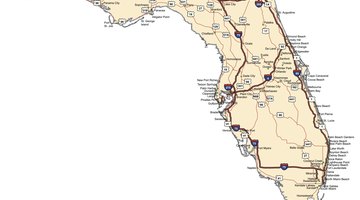When the Spanish began arriving in America in the 16th century, the Apalachee were one of the most influential people they encountered in present-day Florida. This powerful tribe was initially hostile to the newcomers, but they eventually formed an alliance and established a common cultural center at Mission San Luis. When the settlement fell to the British-Creek alliance in 1704, the Apalachee dispersed, and most relocated to Rapides Parish, Louisiana, where some 250 to 300 of their descendants live today.
European Contact
Spanish conquistador Panfilo de Narvaez was the first European to contact the Apalachee, who occupied the area south of the Georgia sate line to the Gulf of Mexico and west from the Aucilla River to the Ochlockonee River. There were probably as many as 60,000 Apalachees prior to European contact, and de Navarez noted that they appeared well-proportioned and strong -- to him, they looked like giants. They were known and respected by neighboring tribes, whom they frequently attacked, for their fierceness as well as for their advanced culture and prosperity,
Apalachee Village Life
The land on which the Apalachee lived featured fertile, loamy soil, and they subsisted primarily through agriculture and foraging, although the men also hunted bear, deer and small game. The crops they grew included corn, beans and squash, and their supplies of corn and other food in their villages were abundant, according to a member of the exploration party of Hernando de Soto, who arrived 10 years after Narvaez. The Apalachees built ceremonial mounds in their villages, some with structures on them. The largest was probably reserved for the chief of the village.
Language and Customs
The Apalachee spoke a Muskeogan language, possibly related to Hitchiti or Creek, but no one speaks it today. When the men went into battle, they covered their bodies with red ocher and put feathers in their hair, a fact noted by the Spanish explorers. They played a ceremonial game with a clay ball about the size of a golf ball. One village would challenge another, and each team might have as many as 100 members. The teams would propel the ball toward the other team's goal with their feet. They dedicated the game to the gods to ensure rain for their crops.
Mission San Luis de Talimali
Despite the hostility with which they first received the Spanish, the Apalachees eventually formed an alliance, and in the 17th century, many of them converted to Catholicism. Together with the Spanish, they established Mission San Luis de Talimali, which stood on the site of present-day Tallahassee. Approximately 1,500 Apalachees occupied the settlement. In 1704, the settlement fell to the British, aided by the Creek confederacy, and the Apalachees dispersed and essentially disappeared. Historians considered the tribe extinct until descendants of some who moved to Louisiana came forward to demand government recognition of their Indian heritage.
Related Articles
References
Writer Bio
Chris Deziel has a bachelor's degree in physics and a master's degree in humanities. Besides having an abiding interest in popular science, Deziel has been active in the building and home design trades since 1975. As a landscape builder, he helped establish two gardening companies.











